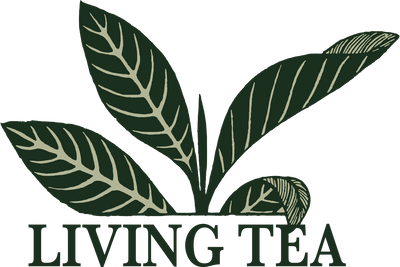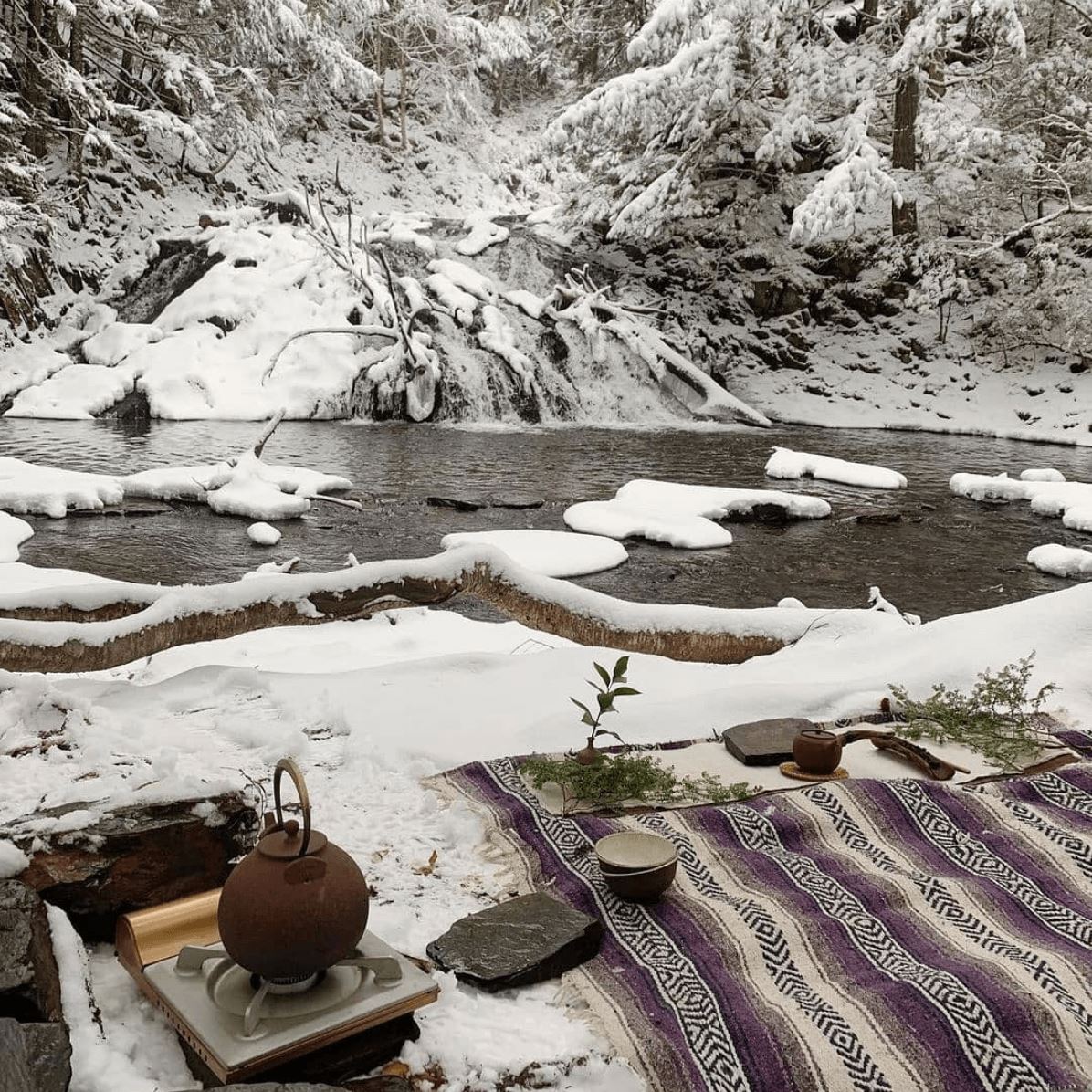Seasonal Tea Club
Winter 2022
The last Autumn leaves fall to the cold, dry earth. The barren trees create a sense of spaciousness through which winter light becomes ethereal. Rising from the lungs, the breath becomes visible in the air, evoking a sense of more space to breath. The snow arrives unannounced and falls silently, a blanket to smooth out the markings of distinction and separation across the landscape. Less distraction for the senses, less desire to go out into the world. During this time of the year, we might settle into ourselves, finding a deeper connection to the bare truth of our existence. During the winter the earth becomes a seed. Dead on the surface, its potential is frozen deep within. The tendency of water to freeze during the winter is associated with the water element’s powers of focus and concentration. Nature suggests we focus on the purely essential and allow the non-essential to fall away. This is the time of year to rest in the awareness and inner space within which the words on this page are being perceived and become thoughts. Without that awareness, there would be no perception, no thoughts, no world.
You are that awareness, disguised as a person. The winter is a time to cultivate inner stillness. When you lose touch with inner stillness, you lose touch with yourself. When you lose touch with yourself, you lose yourself in the world. Your innermost sense of self, of who you are, is inseparable from stillness. We all carry a unique ability to find stillness amidst winter activity and perhaps while drinking winter teas. When we become aware of silence, we enter a state of inner still alertness. We become present. We have stepped out of thousands of years of collective human conditioning.
We might ask ourselves what we truly need. Do we need more information, more bite-size consumable media, more knowledge, more intellectual analysis, faster computers? Is this what we need? Or, do we need more wisdom? Wisdom comes with the ability to be still. Just sitting, just looking, just listening, just heating water. No more is needed. These practices activate the non-conceptual intelligence within us. During the winter, we can cultivate stillness to direct our words and actions. A beautiful poem comes to mind, by Billy Collins, that speaks to the ways in which we might find live from this inner stillness, deeper than name and form.
Shoveling Snow with Buddha
In the usual iconography of the temple or the local Wok
you would never see him doing such a thing,
tossing the dry snow over a mountain
of his bare, round shoulder,
his hair tied in a knot,
a model of concentration.
Sitting is more his speed, if that is the word
for what he does, or does not do.
Even the season is wrong for him.
In all his manifestations, is it not warm or slightly humid?
Is this not implied by his serene expression,
that smile so wide it wraps itself around the waist of the universe?
But here we are, working our way down the driveway,
one shovelful at a time.
We toss the light powder into the clear air.
We feel the cold mist on our faces.
And with every heave we disappear
and become lost to each other
in these sudden clouds of our own making,
these fountain-bursts of snow.
This is so much better than a sermon in church,
I say out loud, but Buddha keeps on shoveling.
This is the true religion, the religion of snow,
and sunlight and winter geese barking in the sky,
I say, but he is too busy to hear me.
He has thrown himself into shoveling snow
as if it were the purpose of existence,
as if the sign of a perfect life were a clear driveway
you could back the car down easily
and drive off into the vanities of the world
with a broken heater fan and a song on the radio.
All morning long we work side by side,
me with my commentary
and he inside his generous pocket of silence,
until the hour is nearly noon
and the snow is piled high all around us;
then, I hear him speak.
After this, he asks,
can we go inside and play cards?
Certainly, I reply, and I will heat some milk
and bring cups of hot chocolate to the table
while you shuffle the deck.
and our boots stand dripping by the door.
Aaah, says the Buddha, lifting his eyes
and leaning for a moment on his shovel
before he drives the thin blade again
deep into the glittering white snow.
THE WINTER COLLECTION
Living Tea seeks out farms or wild tea gardens that have a healthy, reverent relationship to all aspects of tea production. The following are qualities of a Living Tea: seed propagation instead of trees from grafted clippings with shallow roots, plenty of room for the trees to grow instead of tight rows like you see on tea plantations, biodiverse growing regions instead of clear-cut mountainsides or valleys, growing practices that avoid all chemicals including pesticides, chemical weed-killers and fertilizers, no irrigation, and living wages for all employees.
During the winter we tend to drink shou and aged sheng puerh, malty Yunnan red teas, strong yencha rock oolong, heavily oxidized and dark, aged oolong. These teas are rich, full-bodied, flavorful, grounding, earthy, vegetal and deep. Aged tea and shou puerh are warming in the body, which is helpful during the colder months. Puerh support digestion, which is helpful as we eat heartier meals during the winter. Further, we often drink tea later in the day during the colder months because we spend more time indoors. Shou Puerh and rich sheng puerh facilitate quietude, reflection, and relaxation, which are ideal states as we wind down for meditation. Red teas tend to be more moving and enlivening, so we drink them on cold mornings when we feel sluggish or when the limited activities of winter are creating stagnation in the body.
WINTER TEA SERVINGS: We recommend using 4-6 gm of tea per session, or simply, use enough leaves to lightly cover the bottom of the pot. This is true as a general rule of thumb for all teas included in this collection.
BREWING WINTER TEAS: We recommend brewing all of the winter teas with water between 200 and 210 D Fahrenheit, pouring off the first flash steeping to "awaken the leaves," and brew the first five to six steepings for very short amounts of time (2-4 seconds). This practice of short steepings is different than European tea whereby you steep the tea for a long time.
White Eyes - Lincang Mountain Sheng Puerh Blend - Yunnan, China 2021/22
An exquisitely balanced blend of Spring 2021 and 2022 leaves, White Eyes sustains a panoply of bitter, astringent and sweet flavors that change over many steepings. We enjoy the oily thickness of the brew and lively Qi. This tea is wonderful for sunny winter days when you want a thick, yet bright and complex young puerh. We suggest brewing it with water around 200 degrees Fahrenheit, and ideally gong fu in a small zisha pot with small cups. Make sure the steepings are short initially so as not to bring out too much bitterness. Oh, and while you’re at it, you might enjoy the poem White Eyes by Mary Oliver.
Before the Dawn - Classic Dian Hong Red Tea – Feng Qing County, Yunnan, China 2022
Processed in the traditional manner for Feng Qing teas, Before the Dawn is lightly oxidized and roasted. The processing brings out a nice balance of berry, floral and earthy notes. The astringency gives a nice, bold structure to the lighter tea and we find it more robust than all-bud Dian Hong red teas. The energy of the tea is gently uplifting and wonderful for early morning sessions.
Dian Hong teas are red teas that are native to Yunnan Province in Southwest China. Feng Qing Dian Hong is a red tea that stands out for its large number of golden buds. Known as "Yunnan red tea", it’s one of the best known red teas in China. In the west, we refer to red tea as black tea, and this distinction is important because there is another and very different category of tea that is true black tea. While the taste of inferior varieties of Feng Qing can be quite bitter and astringent, high-quality Feng Qing Dian Hong is sweet and intensely aromatic. Many of the best Dian Hong red teas are produced in Feng Qing, due to the ideal climate and masterful processing. To produce this tea, only the bud and the first leaf are picked at the beginning of spring. The production methods are very traditional, "Gong Fu" style, in order to obtain a refined, complex and fragrant tea. Thus, we recommend brewing it “gong fu” in small pots with small cups. We prefer it brewed with less leaves than other teas in order to bring out the sweetness, and water right around 195-200 D Fahrenheit.
Silent Illumination – Mei Zi Qing Village Red Tea – Lincang, China - Spring First Flush 2022
A full-bodied Spring 2022 red tea from 150 year old trees that grow around the remote village of Mei Zi Qing. The flavor profile is complex with a floral berry and rose sweetness that transforms into earthier notes with subsequent steepings. The mouthfeel is ample with depth of flavor that lasts throughout the session. The Qi is gentle and moving. This is clean Yunnan hong cha that draws one back to it after the first session. We found ourselves wishing we had more when we first ran out. Best brewed gongfu or sidehandle with water at 200 D Fahrenheit.
Riversong – Loose Leaf Gong Ting Shou Puerh – Simao, Yunnan China Spring 2020
A friend sent us some of this certified organic (uncommon for this type of tea) gong ting shou to try, knowing that we have a penchant for this type of tea, especially during the colder months. The gong ting grade leaves are very small, juicy and loaded with flavor. We were able to get more of this beautiful tea to share with the winter tea club. The body of the tea is thick and oily with a dark chocolate finish. We appreciate the patience of the tea and found ourselves drinking it for long sessions then boiling the leaves afterwards in a glass kettle. This is winter tea at its finest. We suggest brewing it gongfu with a small filter in the clay body to catch the small leaves. Water is best just shy of a rolling boil. Enjoy!

